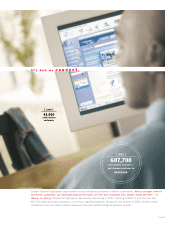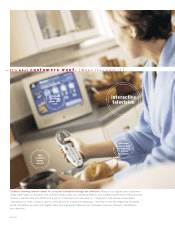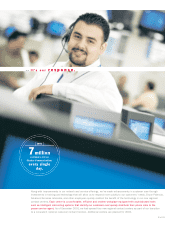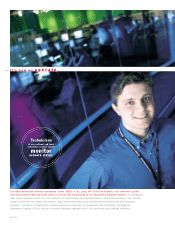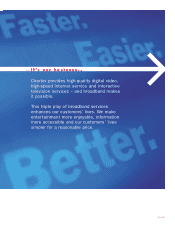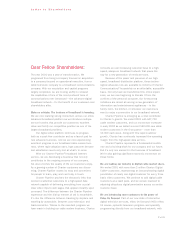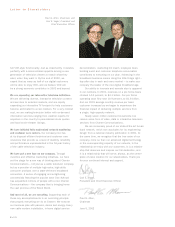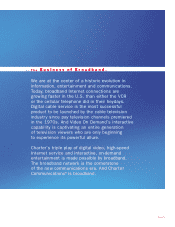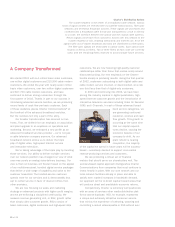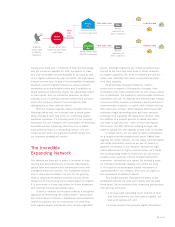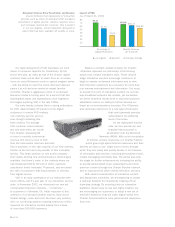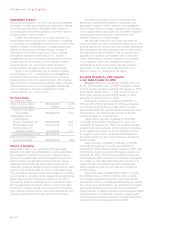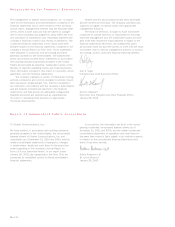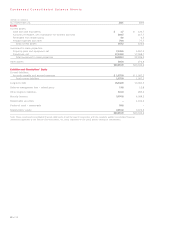Charter 2001 Annual Report Download - page 12
Download and view the complete annual report
Please find page 12 of the 2001 Charter annual report below. You can navigate through the pages in the report by either clicking on the pages listed below, or by using the keyword search tool below to find specific information within the annual report.
10 of 25
A Company Transformed
We started 2001 with 6.4 million basic video customers,
one million digital customers and 215,900 cable modem
customers. We ended the year with nearly seven million
basic video customers, over two million digital customers
and 607,700 cable modem customers, and have
continued to deliver strong momentum through the
first quarter of 2002. Thanks in part to our success in
introducing advanced service bundles, we are producing
record levels of cash flow per basic customer. Each
of these statistics places Charter Communications®at
the forefront of the advanced broadband evolution.
But the numbers tell only a part of the story.
Our broader transformation has occurred on two
fronts. First, we shifted from an emphasis on acquisition
and plant upgrade to an emphasis on operations and
marketing. Second, we embraced a new profile as an
advanced broadband services provider – we’re not just
a cable television company anymore. Our advanced
broadband network allows us to deliver the triple
play of digital video, high-speed Internet service
and interactive television.
We’re taking advantage of the triple play by bundling
these services. Our ability to deliver multiple services
over our network platform has changed our view of what
once was purely an analog video-delivery business. Our
view is that our business will flourish based on the appeal
of our multidimensional, bundled digital service packages
that deliver a wide range of capability and value to the
customer household. The bundled-service customer
spends more for our services and is demonstrably less
apt to curtail service in favor of discount offers from
other providers.
We are now focusing our sales and marketing
strategy on advanced products with higher profit margins,
and we are enforcing a disciplined credit policy. We
measure revenue generating unit, or RGU, growth rather
than simply video customer growth. RGUs consist of
basic customers, digital customers and high-speed data
customers. We are now fostering high-quality customer
relationships rather than those that revolve solely around
discounted pricing. Our new emphasis on the Charter
bundle already is producing results: during the first quarter
of 2002, customers subscribing to both digital cable and
cable modem service churned, or disconnected, at a rate
one third less than that of digital-only customers.
In 2001 and continuing into 2002, we have been
among the industry leaders in digital penetration, high-
speed Internet customer growth and the introduction of
interactive television services including Video On Demand
(VOD) and i-Channels. In each of these advanced broad-
band service categories, we
are generating continued
customer, revenue and cash
flow growth. This growth is
occurring at the same time
that our capital expendi-
tures decline, causing the
economic balance of our
company to shift. As our
plant rebuild is nearing
completion, the majority
of the capital we spend in future years will be success-
based – selectively devoted to support incremental
revenue-producing services and customers.
We are producing a robust set of financial
metrics that should serve our shareholders well. The
success-based capital approach distinguishes Charter
Communications from companies that must continue to
invest heavily in plant. With our core network and our
local network facilities already in place and able to
satisfy even marked increases in bandwidth demand,
our approach will be to direct capital toward areas that
will produce direct and predictable economic returns.
Competitively, Charter is extremely well positioned,
with an array of services other media distribution plat-
forms cannot duplicate. VOD, for example, represents
a unique and extremely attractive consumer service
that mimics the experience of selecting, watching and
controlling a rented videocassette or DVD without ever
Charter’s Distribution System
The master headend is the center of a broadband cable network. Various
kinds of signal content are received here via satellite transmissions, fiber-optic
networks and terrestrial broadcast sources. These signals are processed and
combined into a broadband cable format and transported to a hub or directly
to a node, the interface between the optical and the coaxial cable systems.
Return signals come back from customers’ homes over this network to the
master headend or hub, enabling interactivity and Internet use. All of the
signal traffic out of master headends and hubs are distributed via fiber-optics.
The fiber-optic signals are terminated in optical nodes. Each optical node
location is fed by six fibers. Two or three fibers at each node are currently
used, with the remaining fibers reserved to accommodate future services.



